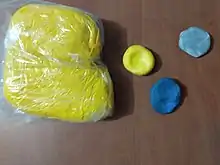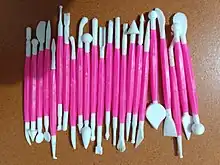
Cold porcelain is a crafting material most commonly made from cornstarch and white glue, not from porcelain as its name would suggest. The material can also include small amounts of oils and glycerol. Because most of the ingredients are biodegradable, lemon juice or sodium benzoate are sometimes used to prevent the growth of bacteria and fungi. It is most often used for at-home crafting and sculpting due to it drying from air exposure rather than heat curing. The material can also be dissolved by heat or water.[1]
Use recommendations
Cold porcelain tends to behave like plasticine thanks to its composition, consistence, softness, and malleability. After it dries it becomes stronger and similar to porcelain. To preserve this material is important to save it in a place where remains hermetically closed. If the material turns a bit dry, it could be soft again if it is mixed with water. This material turns very sticky after mixing it with too much water, to reduce its sticking degree it is recommendable use cornstarch or Vaseline. White glue for manual arts is the most indicated to paste to pieces of cold porcelain.
Colors
There are three easy ways to dye cold porcelain, one of them is using oil paint that can be mixed with the amount of material used, and the others are using acrylic paint or using different color powders that are made of different dyes.
Another way to give color to the sculptures or the objects designed in cold porcelain is by means of a painting brush and acrylic paint, because is possible to paint over this material after it is stronger and dry. The colors when cold porcelain is dyed always turns darker when the material dries, and make that it dries faster.
Working tools

Since cold porcelain has a similar consistency to other materials like plasticine the most appropriate working tools are plastic tools or metal and plastic stilettos, scissors, rolling pins and cutters.
See also
References
- ↑ Peck, Tombi; Dunn, Alan (1998). Modelling in Cold Porcelain. E. P. Dutton. ISBN 9780953258802.